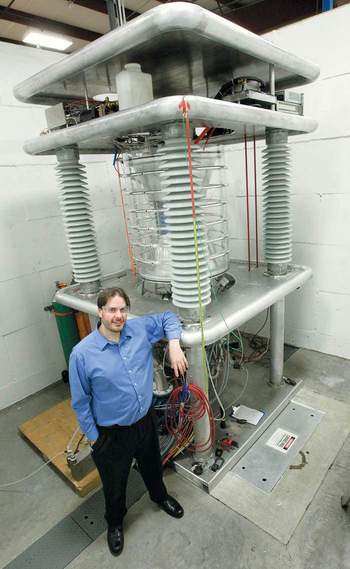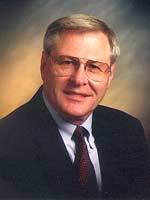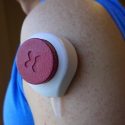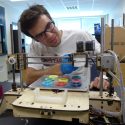UW-Madison spinoff on track to build medical isotope source in Janesville
Shine Medical Technologies of Madison is moving ahead with an effort to make a vital medical isotope at a new plant in Janesville.
The isotope, molybdenum-99, is needed for about 20 million procedures annually in the United States alone. “Moly-99” quickly decays into a form, technetium-99, that is useful for medical scans used to detect cancer and assess blood supply to the heart.
The UW–Madison spinoff’s Janesville plant is slated to employ about 150.

Greg Piefer with the neutron generator he invented. Ions are generated at the top, accelerated in the center, and make neutrons at the bottom when they collide with a gas.
Photo courtesy of Shine Medical Technologies
Approval from the Nuclear Regulatory Commission could come early in 2016, says Shine CEO Greg Piefer, who began pursuing technology that can make the isotope while a UW–Madison graduate student in the 1990s.
Today, moly-99 is made from highly enriched uranium, a substance that can be diverted to make nuclear weapons. The federal government is supporting alternative tactics to supply moly-99.
That support has included $25 million to the Shine project, which includes Phoenix Nuclear Labs, a Madison startup that Piefer opened in 2006 to make a powerful neutron accelerator he invented.
That accelerator is at the core of Piefer’s plans to produce moly-99.
Piefer credits Gerald Kulcinski, leader of the UW’s fusion program, with suggesting the use of fusion to create neutrons that could transform isotopes. Nuclear fusion is best known for its potential to provide clean, practically limitless electricity. But that Holy Grail remains elusive, so in the 1990s, Kulcinski steered his students toward profitable, near-term applications of fusion, such as making moly-99.
The Phoenix neutron accelerators — the world’s most powerful commercial models — create a small fusion reaction that releases a cloud of neutrons that can, in turn, produce moly-99 by the fission of a uranium-based compound.
In 2008, Canada announced that it would close the old reactor it was using to make moly-99, closing off a significant fraction of the current U.S. supply. Other sources in Europe, South Africa and Australia are so distant that the one percent per hour decay drives a major increase in cost.

Gerald Kulcinski
With the valuable moly-99 market suddenly in play, Piefer opened Shine in 2010 and began planning a safe, profitable and proliferation-proof method to make the necessary isotope.
Although Piefer has left Phoenix, he plans to use up to eight Phoenix accelerators to make moly-99.
A massive application to the NRC has been underway for years, and Piefer hopes for a favorable decision early in 2016.
Site, access and safety are all paramount concerns for Shine, and Piefer thinks he’s found an ideal site on the south side of Janesville. “The soil is stable,” he says. “It’s far from seismic activity and has a fairly deep water table — we don’t want any water encroachment in the plant.”
Rapid air travel is a must. The half-life of moly-99 is only 66 hours, so more than 75 percent of the isotope has decayed in just six days. The Southern Wisconsin Regional Airport is adjacent to Shine’s proposed site, and O’Hare is only a couple of hours by road.
Finally, the project needs to convince its host community that the technology is safe. John Beckord, president of the economic development organization Forward Janesville, says, “Greg and his team have made every effort to communicate factual information about the project and the product, the science behind it, and the regulatory process. They have been open to answering questions, and that has won people over.”
Janesville has offered a series of valuable economic incentives. “We are a startup and we need every bit of help we can get to reach the market,” Piefer says.
Shine and Janesville are an ideal mix of politics, economics and technology, says Beckord. “Shine has discovered a community and a city council that look favorably at a project that will create jobs and new investment. This is an example of brainpower, ideas, entrepreneurship coming from the university and finding its way into a community outside of Dane County.”
Subscribe to Wisconsin Ideas
Want more stories of the Wisconsin Idea in action? Sign-up for our monthly e-newsletter highlighting how Badgers are taking their education and research beyond the boundaries of the classroom to improve lives.



